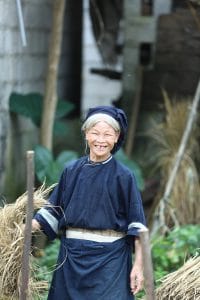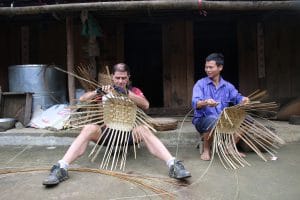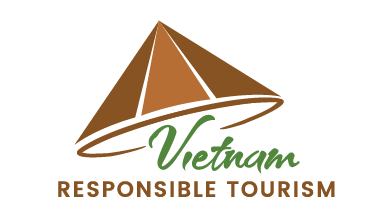With the development of the market economy, there are many customs and cultural characteristics of the ethnic minorities are more or less faded away, however, Nung An people in Quang Uyen district of Cao Bang province still preserve many cultural features.
Nung An people live in four main communes: Phúc Sen, Đoài Khôn, Quốc Dân, Tự Do in Quang Uyen district, which has a long tradition of culture, presented through material culture, spiritual culture and social relationships.
In the material culture tradition of Nung An, the most noteworthy feature is the preservation of traditional costumes. Their clothes are designed and cut simply but carefully from the indigo fabrics they make themselves. Most notably, the Nung An people often wear traditional costumes of their own ethnicity, although many other ethnic groups have used modern costumes more often. They wear traditional attire in all activities such as going to work, going to school, going to markets, or in festivals, from the elderly to the children, from women to men, all dressed in indigo. Any Nung An children who work in any position, when they return to the village, will wear these costumes before going out, visiting their relatives, neighbors or working in the family fields.
 In addition to agricultural producing, the Nung An also make handicraft to serve the needs of daily life and to increase income. With the hard-working feature, most of Nung An people are skillful craftsmen. Women are spinning cotton, weaving fabrics, dyeing indigo; Men are forging, casting. In addition, there are many other jobs such as making paper and making incense in Quoc Dan commune, making tile in Tu Do commune. Traditional jobs have helped to solve the problem of joblessness in the leisure agricultural days. At the same time, this occupation has become a major source of income, contributing to the improvement of people’s life and culture. The preservation and promotion of traditional crafts is a unique feature of the Nung An, which cannot be mixed with any other.
In addition to agricultural producing, the Nung An also make handicraft to serve the needs of daily life and to increase income. With the hard-working feature, most of Nung An people are skillful craftsmen. Women are spinning cotton, weaving fabrics, dyeing indigo; Men are forging, casting. In addition, there are many other jobs such as making paper and making incense in Quoc Dan commune, making tile in Tu Do commune. Traditional jobs have helped to solve the problem of joblessness in the leisure agricultural days. At the same time, this occupation has become a major source of income, contributing to the improvement of people’s life and culture. The preservation and promotion of traditional crafts is a unique feature of the Nung An, which cannot be mixed with any other.
The existence and development of handicrafts here is not only significant in terms of economics but also the traditional meaning of hard-work education for generations to come. As from wearing traditional clothing, they maintain the indigo fabric work, first of all, to solve the problem of self-sufficiency, but more importantly, to train the descendants of the family consciousness of working hard. Therefore, the women here before getting married should know weaving, dyeing Indigo, otherwise, they will be considered lazy, as well as men asking the wife for marriage not knowing how to forge considered incompetent and not worthy of the breadwinner family. Meanwhile, they also encourage and facilitate their children to go to schools and acquire new knowledge in order to catch up and keep up with other peoples, while preserving and promoting the beauty of national identity.
 Speaking of entertaining activities, the Nung An has their own featured singing activities called hèo phươn, which means ‘calling friends to sing with’. Hèo Phươn is often sung during the fun, festivals, weddings, ceremonies, welcome home parties, praying for seasons period. This activity conducted in the dialogue between men and women. The Hèo Phươn is structured in pairs, with 2 sentences sung by each person, each with 10 words. When singing, there are two men and women, one person singing a low voice, one singing a high voice, and they sing in response to one another. Deep voice and high pitched voice mix into each other evenly until the end of each sentence.
Speaking of entertaining activities, the Nung An has their own featured singing activities called hèo phươn, which means ‘calling friends to sing with’. Hèo Phươn is often sung during the fun, festivals, weddings, ceremonies, welcome home parties, praying for seasons period. This activity conducted in the dialogue between men and women. The Hèo Phươn is structured in pairs, with 2 sentences sung by each person, each with 10 words. When singing, there are two men and women, one person singing a low voice, one singing a high voice, and they sing in response to one another. Deep voice and high pitched voice mix into each other evenly until the end of each sentence.
The spiritual life of Nung An people is rich and varied. They have deep faith in divine, supernatural forces. There is usually a shrine at the beginning of the village. The ceremonies are held on the holidays, Tet in the year as the Lunar New Year, the full moon in July, the Thanh Minh Festival … The ritual practitioners are worshipers Tào and fairy women. Worshipers Tào play an important role in many rituals such as the worship of the newborn, weddings, funerals and lands, etc. People here have Tet – celebrations – almost every month, each Tet with its own characteristics: January has Lunar New Year, March has Thanh Minh, May has worm-killing Tet, or Thanksgiving Tet for parents, etc.
Coming to Cao Bang enjoying the full-featured distinguished unique traditions and customs, it also worths discovering the people and their lives there, and the Nung An is one of the subjects you must not miss!
Trang Dam
Read more:
